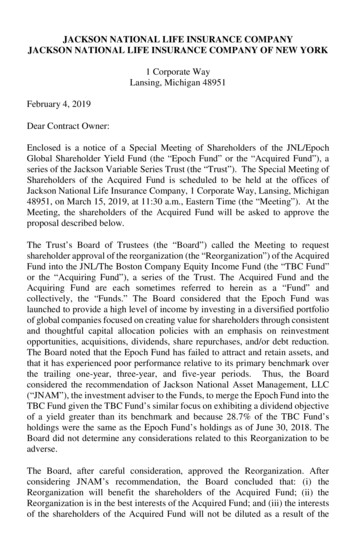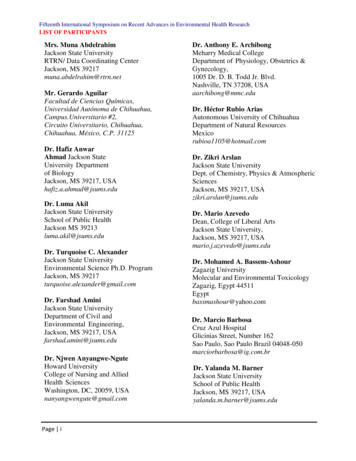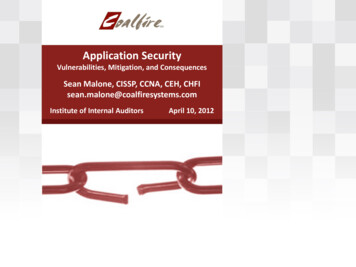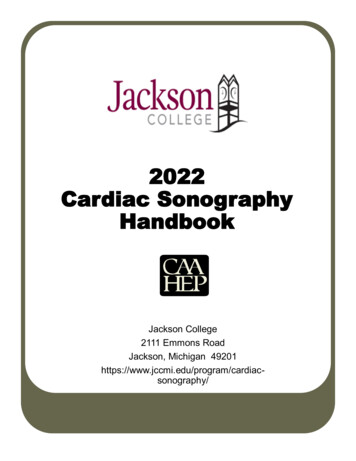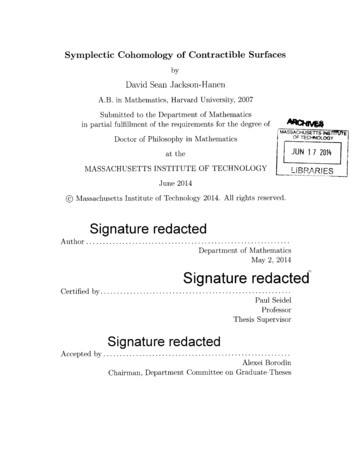
Transcription
Symplectic Cohomology of Contractible SurfacesbyDavid Sean Jackson-HanenA.B. in Mathematics, Harvard University, 2007Submitted to the Department of Mathematicsin partial fulfillment of the requirements for the degree ofDoctor of Philosophy in MathematicsASSACHUSETTS INSiOF TECHNOLOGYJUNat theMASSACHUSETTS INSTITUTE OF TECHNOLOGYJiBRARIESJune 2014@ Massachusetts Institute of Technology 2014. All rights reserved.Signature redactedA u th or .Department of MathematicsMay 2, 2014Signature redactedC ertified by .Paul SeidelProfessorThesis SupervisorSignature redactedA ccepted by .Alexei BorodinChairman, Department Committee on Graduate-Theses17 2014IE
Symplectic Cohomology of Contractible SurfacesbyDavid Sean Jackson-HanenSubmitted to the Department of Mathematicson May 2, 2014, in partial fulfillment of therequirements for the degree ofDoctor of Philosophy in MathematicsAbstractIn 2004, Seidel and Smith proved that the Liouville manifold associated to Ramanujamssurface contains a Lagrangian torus which is not displaceable by Hamiltonian isotopy, andhence that higher products of this manifold provide non-standard symplectic structures onEuclidean space which are convex at infinity. I extend these techniques a wide class ofsmooth contractible affine surfaces of log-general type to produce a similar torus. I thenshow that the existence of this torus implies the non-vanishing of the symplectic cohomologyof the Liouville manifolds associated to these surfaces, thus confirming a portion of McLeansconjecture that a smooth variety has vanishing symplectic cohomology if and only if it isaffine ruled.Thesis Supervisor: Paul SeidelTitle: Professor3
4
AcknowledgmentsFirst and foremost I would like to thank my advisor, Paul Seidel. Over the past few yearshe has provided a seemingly endless well of fantastic ideas and suggestions; his influence onthe following will be immediately apparent. Discussion with Sheel Ganatra, Mark McLean,Ivan Smith, Mohammed Abouzaid, and Tomasz Mrowka were all very helpful. I wouldalso like to thank my fellow graduate students, in particular Tiankai Liu, Ailsa Keating,and Nate Bottman, for support both mathematical and personal. It is no exageration tosay that I would not have been able to complete this process without them. The researchconsitituting this thesis was partially suupported by NSF grant DMS-09437875
6
Chapter 1IntroductionIn [24], Seidel and Smith proved that the Ramanujam surface-the first known topologically contractible algebraic surface, constructed in [21]- considered with its natural exactsymplectic structure contains a Lagrangian torus which cannot be displaced from itself viaHamiltonian isotopy. A itself is not homeomorphic to R 4 , but for n 2 A" is diffeomorphicto R 4n by the h-cobordism theorem. Thus, the A" provide examples of non-standard symplectic structures on Euclidean space. This was not the first example of an exotic symplecticstructure on Euclidean space-Gromov constructed the first in [10]-but it was the first suchstructure which is convex at infinity, in the sense that outside a compact set it is isomorphicto the positive half of the symplectization of a contact manifold. Convex symplectic manifolds are particularly appealing to study, since they admit good Floer theories that allowone to define objects such as symplectic cohomology and, in many cases, Fukaya categories.Over the next half-decade, work by McLean[18] and Seidel and Abouzaid[3] produced manymore exotic convex manifolds, eventually showing that all Liouville manifolds of dimensionat least 6 admit infinitely many pairwise non-isomorphic Liouville structures. Most of thesefurther exotica were produced via careful choices of Legendrian handle attachment, henceleaving the algebraic category of the initial results (which is not, of course, to say that therehasn't been further work on the symplectic geometry of affine varieties; e.g. McLean[19]proves that for contractible surfaces log-Kodaira dimension is a symplectic invariant.) Thisthesis extends the argument of [24] to more general contractible surfaces of log-general type.Theorem 1.1. Let A be a smooth contractible surface of log-Kodairadimension 2, satisfyingAssumption 7.1 and Assumption 9.1. Then the symplectic cohomology SH*(A) is nonvanishing.Proof. Overview Let X D A be a smooth projective surface containing A such that DX \A is a curve with at worst normal crossing singularities, and equip X with a Kahler formwx (These notions will be explained in more detail in section 3). Let J' be an w-compatiblealmost complex structure on X with J' Jtnrd near D. Let p E D be a crossing point,and form Y as the blow-up of X x CP 1 C U {oo} at the point (p, 0); Y is known as thedegeneration to the normal cone of X at P, with its projection map -r : Y - CP1. For X.t j 0 we have a natural identification Y 7r-'(t)7
Y has a symplectic form wy for which the natural extension of J' x JCpto Y is Wycompatible. Y contains a Lagrangian submanifold with boundary, K UtE[ ,,EKt, forsome small real E 0, such that Kt 7r- (t) n K is a Lagrangian crossing torus at p for Ywhen t 0, and a Clifford torus in the exceptional fibre for t 0.Suppose, for a moment, that the minimal energy of non-constant J' holomorphic discsin (Y, Kt) goes to infinity as t -* 0 . By taking Kt for small t to K via symplectic paralleltransport, one then can produce the following situation: a fixed Lagrangian torus K C Aand symplectic form w, and sequence of almost complex structures J 1 , J 2 ,. such that theminimal energy of J holomorphic discs with boundary on K is greater than n. We willshow in section 5 that this condition implies that SH*(A) # 0, where we will also definesymplectic cohomology.In section 4, we show that if the minimal energy does not go to infinity, and if p is chosencorrectly (where the fact that such a correct choice exists is proved in section 9) then thereexists a J' holomorphic map f : CP1 - X with f -1(D) {pt}; in fact the proof providesenergy estimates for f. If we somehow knew that f were an embedding for J' Jtnd,then f would provide an algebraic embedding A'- A, which is impossible by [20 3.4.10;unfortunately there is no way to guarantee that this is the case.Instead, we prove in section 6 that for generic choices of J' which are regularfor holomorphiccurves of bounded energy intersecting D at one point, the homology class B f,([CP'])represented by any such curve must satisfy c1 (B) - B - D 0. Section 7 then proves thatthere no curves that look like Gromov-limits of curves satisfying this homological conditionwith the standard almost complex structure, by examining intersection theoretic constraintsimposed by the relatively minimal model of (X, A, D). The brief section 8 then shows howall of these pieces come together to prove that SH* (A) # 0The above proof also serves as a rough outline of the thesis. Sections 2 and 3 providebasic background on affine surfaces and the symplectic geometry thereof. We note here thatAssumption 7.1 and Assumption 9.1 hold in all examples known to the author, but theyplay rather different roles in the argument; Assumption 9.1 is fundamental in the sense thatwithout it there are no incompressible tori at infinity, and thus no small perturbation ofthe argument in this thesis could work; while Assumption 7.1 is more of a technicality thatcould probably be removed.8
Chapter 2Background geometryWe begin by recalling the Liouville manifold structure on a smooth affine algebraic surface;our presentation draws heavily on [251.So let A be a smooth affine algebraic variety over C.A " A'-Looking at the closure of A inP", we see that there exists a projective variety X with A " X; since Hiron-aka's resolution of singularities [13] proceeds by performing repeated blow-ups along partsof the singular locus, we may assume X is smooth without changing A so that D X \ A isthe support of an ample divisor in X; let H be an ample divisor with supp H D. WhileD will generally of course not be smooth, we assume for now that the singularities of Dare simple normal crossings. In other words, at every point p E D there exists an opencoordinate neighborhood p E U with p (0, 0, . 0) andDfnU {(xl,. Xnlxilxi2 .ik 0,il i2 . ik}Let L O(H). Since L is ample, it admits a Hermitian metric whose curvature is astrictly positive (1, 1) form. More precisely, let s E H 0 (X, L) be a holomorphic section withs- 1 (0) D. On A X \ D, we consider the form w -ddclog(Is[J), where the norm I -[cis taken with respect to the Hermitian metric. Ampleness implies that for some choice ofmetric this is a positive (1, 1) on A, equal (up to a constant) to the curvature of the metric.Note that - log(IsIc) : A -* R is exhausting, i.e. proper and bounded from below. We alsohaveLemma 2.1. All criticalpoints of -log( s1)are contained in a compact subset of A.Proof. Let p E D. We show that a sufficiently small neighborhood V C X of p contains nocritical points of - log(jsIL) in V n A by showing that at particular directional derivative isnon-zero near p.Let U be a small holomorphic coordinate ball around p. Since D is a simple normal crossingdivisor, we may assume that D n U {(x1 , . X) C UjxIx 2 . Xk 0} for some k nafter reordering the variables, while p (0,0 . 0). Llu is trivializable, and we can pick atrivialization such that s x"' . x', such that wi 1, since s vanishes precisely alongD. While the metric I -[I need not agree with the standard Euclidean metric I -1, they arepositively proportional, i.e. there exists ) : U - R such that I - Jc eP'I - I with respect to9
this trivialization. Thend(- log(IsI )) d(- log(e x " - - - xk -db - w 1 dloglxi- - - --)wkdlog IxkIWrite x, in polar coordinates x, r 1 ei01, and (9, the vector field pointing in the positive radial direction for x 1 when x1 0 0. 0 is smooth at 0, hence do( On) a0/Or1 isbounded near 0. On the other hand, widlogIx1l(ari) wi/ri - cc as x 1 - 0, whilewidlog IxiI(ari) 0 for i 5 0. We conclude that d(-log(IsIc))(orJ)- -oo as z - 0, andthus - log(Is c) has no critical points near p.0Note that proof relied essentially on the fact that p was at worst a normal crossingsingularity of D.With this lemma, we see that q -log IsI', gives A the structure of a finite-type Steinmanifold. In other words, 0 is an exhausting (proper and bounded from below) strictlyplurisubharmonic function, which is another way of saying that -dd'g is Kahler, and allthe critical points of # are contained in a compact #-1((-oo, C)) for some C 0. Shifting perspectives slightly, A is an exact symplectic manifold with primitive 9 -dc.TheLiouville vector field associated to 0, i.e. the vector field Z such that 9 w(Z, .), is thenV0, the gradient taken with respect to the associated Kahler metric. In particular, for anyC 0, Z is outward pointing along the boundary of 0-((-oo, C]). This allows us to puta Liouville manifold structure on affine varieties:Definition 2.1. A Liouville domain is a compact exact symplectic manifold with boundary(M, w, 0) with w dO such that the Liouville vector field Z is outward pointing alongY OM. Note that a : 01y is then a contact form on Y. A complete finite-type Liouvillemanifold is an open exact symplectic manifold without boundary (M, w, 9) with w d9 whichcan be written M M Uy Y x [0, oo), where M is a Liouville domain with (4M, 0) (Y, a)and Y x [0, oo) is the positive half of the symplectization of Y, i.e. has symplectic formd(era) for r the radial coordinate on [0, oo). We call Y x [0, oo) the conical end of M.Note that on the conical end Z Z, and hence the flow of Z is defined for all positivetimes (and negative times, as the negative end is capped off by a compact manifold.) Thusthe exact symplectic structure on an affine variety is never a complete Liouville structure,since the associated flow will always hit D in a finite time.However, 0-'((-oo, C]) is a Liouville domain for C sufficiently large. We can then formthe associated complete finite-type Liouville manifold A4 by attaching the infinite coneq-1(C) x [0, oo). A is diffeomorphic to A, and it is easy to see (using the flow of Z)that different choices of C that are sufficiently large give rise to exactly symplectomorphicLiouville manifolds, whence we suppress any mention of C in the notation A.We had to make many choices to define the plurisubharmonic function # on A. The following lemma asserts that A0 does not depend on those choices up to the appropriate notionof isomorphism.Lemma 2.2. Let 0' be another strictly plurisubharmonicfunction on A arisingfrom a section of an ample line bundle with support on the complement of A in some smooth projective10
completion, where the hypersurface at infinity has simply normal crossing singularities. 0'induces an exact symplectic structure (w', 0') and hence another complete Liouville manifold, such that p*0' 0 df, where f isAo. Then there exists a diffeomorphism p : A0 - compactly supported.Proof. We will sketch the proof of this fact; for more details see (19] Section 8.We first need a family version of Lemma 2.1. Suppose that we have two line bundlesLo and L1 together with metrics I - lo and I - 11 and holomorphic sections so and si suchthat so (0) si (0) D as sets; note that we do not assume that either Lo or L1 areample. Let 0 - log solo and #1 - log Isili which are both proper smooth functions onA. Define #t (1 - t)oo to1 . Then all critical points of all (0t)tE[0,1 lie in some compactsubset of A; the proof is almost word for word the same as that of Lemma 2.1.In particular, suppose that L1 and L 2 are both ample. Then #o and 11 are both strictlyplurisubharmonic, and hence so are all 4t. Pick C 0 larger than all the critical pointsof all Ot. Then form Z, by attaching an infinite cone to Ot-((-oo, C]) for all t. ThenOt -dot is a finite-type deformation of Liouville structures on A. A Moser-style argument then proves the existence of a diffeomorphism as in the statement of the lemma. Thisproves independence of the choice of ample line bundle and metric on that line bundle, fora fixed nodal curve.It remains to show that the structure is independent of the choice of curve D. Supposefirst that D' is a blow-up of D, i.e. there exists a blow-up morphism 7r : X' - X withir- 1 (D) D' and the blow-up locus contained in D. D' also supports an ample divisor; letLo be an ample line bundle on X' with section so such that so (0) D', metric I - lo, andstrictly plurisubharmonic function 0 - log IsoI on X' \ D' :: A.are the corresponding data on (X, D), let (Li, si, I-1, #1) (7r*L, r*s, 7r*11, 7r* X'\D,(0)). We have si (0) D', and while Lj is not ample, #1 is still strictly plurisubharmonic, since 7r is a diffeomorphism over X' \ D'. Thus as in the previous paragraph thecomplete Liouville manifold associated to (X' \ D', -do) is Liouville isomorphic the complete Liouville manifold associated to (X' \ D', -do,), and the later is isomorphic via 7r tothat of (X \ D, -d#). Finally, Hironaka's resolution of singularities implies that for anytwo resolutions, there exists a third resolution which is a common blow-up of both of them.Thus the Liouville structure on an affine variety is unique up to Liouville isomorphism. 5Then if (L, s,- ,4)We also need to specify the class of almost complex structures on complete finite-typeLiouville manifolds appropriate for constructing Floer theories. Given a complete finitetype Liouville manifold M with a fixed conical end, we say that an w-compatible almostcomplex structure J is of contact type, or convex, if outside of a compact set -d(er)o J 9,with r the radial coordinate. This condition is equivalent to J(0) R, where R is theReeb vector field on Y. On an affine variety the natural almost complex structure J is ofcontact type, after possibly rescaling the plurisubharmonic function by a constant, and theflow of Z Z preserves J. Thus there is a natural extension of J to a convex almost structure j on A; this is in fact true for any J that is standard outside of a compact subset of A.The preceeding discussion was entirely general; we now specialize to dimc(A) 2.11In
this case, one can ensure that D is a singular Riemann surface with at worst simple normalcrossing singularities, i.e. nodal singularities. Thus the conditional results we have provedin this section apply. We can describe such a divisor via its dual graph as follows: we drawone vertex vi for each irreducible component Di C D, and we draw one edge connectingvi and vj for each nodal singularity of D in Di n Dj. If i 4 j this number is obviouslyIDi f D l, but nodal self-intersections are possible.Lemma 2.3. : Suppose A is a smooth affine surface which is topologically contractible(in the analytic topology), and (X, A, D) is a projective compactification of A with simplenormal crossings. Then the dual graph of D is a rationaltree, i.e. all irreducible componentsof D are rational, and the dual graph is a tree.Proof. This is a simple application of Alexander duality. From the long exact sequence insingular homology we have0o H 3 (D, R) - H3 (X, R) - HH1 (A, R) 0(X, D, R)3Hence by Poincare duality H1 (X, R) 0, and so H, (X, R)sequence we haveo H 2 (A, R) H 2 (X, D, R)-*H,(D, R)But the only nodal Riemann surfaces with H, (D, R) -0. Again using the long exactH(X,R) 00 are rational trees.Since Hi(X, D, Z) H 4 -i(A, Z) 0 for i 2, 3, we have that H2 (D, Z) - H 2 (X, Z) isan isomorphism. This allows us to determine the intersection form of X from D: it is a freeabelian group generated by the images of the irreducible components of D; the intersectionnumbers of distinct components are either 0 or 1 depending on whether they intersect;and the self-intersection numbers of the given components (for this reason, the dual graphis typically decorated with integers at each vertex corresponding to the self-intersectionnumber.)12
Chapter 3Deformation to the Normal ConeIn this section we have a triple (X, A, D) where X is a smooth projective surface, D a curvewith normal crossing singularities supporting an ample divisor H and A X \ D a smoothaffine surface.Definition 3.1. Let p c sing D be nodal point. Let V - p be small coordinate neighborhoodof p with respect to which p (0,0), D n V {x, ylxy 0}, and the Kahler form restrictedto V is standard, i.e. wIu E dzi A dzi. This is possible by Lemma 3.1 below. Then acrossing torus at p is a torus L C V\D which is isotopic inside V\D to La,b {(x, y)I a, yj b} for a, b c R. Note that La,b is a Lagrangian torus.Given a crossing torus L La,b, intuitively what we would like to do is shrink L towardsp, i.e. let a, b - 0, and examine the behavior of holomorphic discs with boundary on L.We will realize this situation via the algebro-geometric notion of degeneration to the normalcone at p, which has the advantage of being smooth even in the limit when the torus shrinks"all the way" to p.Definition 3.2. Forp E X, the Deformation to the Normal Cone of X at p is the varietyY given by the blow-up of X x CP1 at (p, 0)We have a fibration 7r : Y - CP1 . For the t : 0, the fibre Y is isomorphic to X,while for t 0, the fibre consists of two irreducible components, Y Z U P, where P isexceptional fibre (thinking of Y as a blow-up of X x CP', Z is isomorphic to the blow-upof X at p. The intersection Zfn P is equal to a line in P Cp2, and the exceptional divisorin Z.X x CPR is Kahler with the product metric, so by [9] p.185, Y also admits a Kahler metric.It is worthwhile for our purposes to sketch the argument, since we will use details of theconstruction later on.Proof. that Y is Kahler. Consider L O(H) an ample line bundle with metric I - kc,0(1) - CP' equipped with the standard metric, and wxCPi the curvature form of theproduct metric. Letting f : Y - X x CP' be the blow-up, the form f*WXxCp1 is thensemi-positive, and positive away from tangent vectors along P. Now consider 0(-P). In asuitable neighborhood V of P O(-P) is the pullback of 0(1) under V - C3 x CP 2 - CP 2 ,so on V there exists a metric on O(-P) whose curvature gives the pullback of the FubiniStudy metric. Away from V, 0(-p) is trivial, so one can take a constant metric withrespect to that trivialization.13
Patching these metrics with cutoff functions then yields a form w-p which is semi-positiveoutside of a compact subset disjoint from P, and positive along the exceptional fibre of Y.Thus w-p is bounded from below, and for r 0 sufficiently small wxCpi rw-p will bepositive everywhere. Call this metric wy0Note that this proves that IC : n[L 0 0(1)] 0 O(-P) for n sufficiently large is ample.Also, wy restricted to P is isomorphic to the standard Fubini-Study metric on P up rescaling by r.Within P we have three distinguished lines, Co P n Z (i.e. the singular locus of Yo),and C1 and C2 the proper transforms of the two components of D x CP 1 passing through(p, 0). Let Ko c P \ {Co U C1 U C2} be any Clifford torus disjoint from those lines, i.e.viewing P as the quotient of C3, KO is the quotient of S 1 (ri) x Sl(r 2 ) x Sl(r 3 ) for somechoice of radii ri, r2 , r 3. Since wy restricted to P is a rescaled Fubini-Study metric, KO is aLagrangian subspace of P.Away from Co, r : Y -* CP' is a submersion with symplectic vertical tangent spaces.Hence wy defines a symplectic connection for 7r away from Co by taking the horizontaltangent space to be the symplectic orthogonal complement to the vertical. Using this connection, we transport KO over [-e, e} to get K, a real 3-manifold with boundary. We willneed the following two facts about K.(a) K C Y is Lagrangian. To see this, note that since Ko C Yo is Lagrangian and theconnection is symplectic, Kt C Y is Lagrangian. But for any x E Kt, TxK splits as a onedimensional horizonal space direct sum TxKt, hence wy vanishes on K and K is Lagrangian.(b) For each t 0 sufficiently small, Kt is isotopic to a crossing torus in Yt a X. To seethis, note that since the space of all connections for 7r is contractible, if K' is constructedsimilarly to K using some other connection, then K' is isotopic to K via an isotopy thatcovers 7r. If t is sufficiently small this isotopy will avoid the total transform of D x CP1,since Ko K01 n D x CP 1 0. But near t 0 one can pick a local trivialization of thesituation, and the trivial connection with respect to that trivialization, for which it is clearthat Kt is a crossing torus. See [24] p. 15 for more details.Consider the section of r*L vanishing along b proper transform of D x CP', the section of7*0(1) vanishing along Y,, and the already described meromorphic section of 0(-P)witha pole along P. These together give a section sK of ICvanishing precisely along b U Y U Pwith 4 - log IstI a strictly plurisubharmonic function on Y \D U Y U P. For each t # 0,t : 4y\st is a strictly plurisubharmonic function on Y \ Dt X \ D, with associatedKahler form wt -ddq5.Recall that the meromorphic section of O(-P) has norm 1outside of a neighborhood of P; hence for some t 0 #t is proportional to q5, the originalstrictly plurisubharmonic function on A X \ D. Thus wt provides a deformation of theoriginal Liouville structure on A.3.1Recall that we defined the Lagrangian K UtE[EEIKt by symplectic parallel transport viathe symplectic connection induced by the fibration Y - CP1 . It will be useful for us to14
ensure that this parallel transport preserves the divisor at infinity. More precisely, we haveD the proper transform of D x CP 1 , and for t E CP', t # 0, D : bn Y. For t, s #0 E CP ,let py : Y - Y, be the symplectic parallel transport for any path from t to s avoiding 0.Then we would like p.)(Dt) D,.The symplectic form on Y is given by wy wxCP rw-p for some r 0 sufficiently small.Here wxxcp is the semi-positive form pulled back from X x CP' and w-p is supported ina small neighborhood of P, the excepional divisor, and restricts to the Fubini-Study formon P. wxCp, coming from a product metric, certainly preserves b, and hence so does wyfor fibres sufficiently far from 0. w-p, on the other hand, has a priori nothing to do withD. Our aim in this section is to show that we can modify the symplectic structure on Y toensure that D is preserved under parallel transport. NamelyProposition 3.1. There exists a choice of metric I -I on the ample line bundle L, givingthe symplectic form on X and hence defining the semi-positive form wX CP1 ; and a formW' on Y which restricts to the Fubini-Study form on P; and a constant r 0 such thatw/y wxxCp1 rw' is Kahler and if p' is parallel transport with respect to w' , thenp'(Dt) D, for t, s 5 0 and y a path from t to s in CPF \ {0}.Proof. Note that by considering the reverse path and noting that the composition is theidentity it suffices to show that p'(Dt) C D. The key to the proof is the fact that w-p issupported in a small neighborhood of the exceptional fibre admitting a torus action, andmaking w-p invariant under this torus action is sufficient to guarantee the conclusion ofProposition 3.1.At the crossing point p C X we have irrreducible components Dx and DY of D such that{p} Dx n Dy and an open coordinate chart V such that p (0, 0), Dx n V { (x, y) ly 0}and DY n V {(x, y)x 0}.Lemma 3.1. After possibly shrinking V, we may assume the metric the associatedKahler form w is standard on V, in the sense that wIv on L is such thatE dzt A &-.Proof. We first note that on any Kahler manifold M with form W and p E M with contractible neighborhood U and a different Kahler form wo on U, after shrinking U thereexists an exact perturbation of w which is equal to wo on U. More precisely, let h : M - Rbe a smooth function with compact support such that on U,h Kahler potential of wo -Kahler potential of wluThen w' w O5h is a global form which restricts to wo on U. Of course, for a generalchoice of h, w' will not be a Kahler form, but if the functional form of h is chosen carefullythen w' will be Kahler. See [22] Lemma 7.3 for details on how to choose h.Now apply this result to the open set V containing p and the standard Kahler form withrespect to the coordinates on V; let h : X - R be as in the previous paragraph. Modifythe metric I -I on L by I-I' e-h/ I- . Then for the holomorphic section s with s-1(0) Dwe have - log IsI' h/4 - log Isi, and so ddc(- log IsI') 'Oah - ddc log Is1, which byconstruction is standard on V.E15
I-I hasSo we may assume that the metricbeen chosen to be standard on V. ReplacingV by a polydisc centered at p contained in V, we have a an action of T 2 R/Z x R/Z onV given in coordinates by T(a,b) - (x, y) (e 2 7iaX, e 2 7riby). The standard metric is obviouslyinvariant under this action, so wlv is T 2-invariant. This T 2 action induces two circle actionsgiven by the sub-circles T- {0} x R/Z and Ty R/Z x {0}. Note that the fixed set of Txis Dx n V and the fixed set of Ty is Dy n V.This T 2 action extends to an action on V x CP1 trivially on the second factor. LetV ir- 1 (V x CPI') C Y under the blow-up map 7r. Then the T 2 action on V \ P extends smoothly over P; indeed, if [x : y : z] are homogenous coordinates on P induced bythe coordinates on V, then the extension is given by r(a,b) - [X : y : z] [e2 7rax . e 2 7riby : 1which is the restriction of the action of U(3) on Cp 2 to a torus.The form w-p was constructed by taking the pull-back of the Fubini-Study form and multiplying by a cut-off function in a neighborhood of P. By shrinking the support of the cut-offfunction we can ensure that there is an open set W c Y such that supp w-p C W C W C V.Since we have a T 2 action on V, we can average w-p by this action. More precisely, for anyq E V, we define the form w' at q by(w-p)q : Ji-ab)(W-P )(,b)qdWhere dp is Haar measure on T 2 . The Fubini-Study metric on Cp 2 is invariant underthe action of U(3), and since w-p restricts to the Fubini-Study metric on P, W'p alsorestricts to the Fubini-Study metric on P.Thus wT , is a form which restricts to the Fubini-Study metric on P, is semi-positive insome neighborhood of P, and is bounded from below. Hence exactly as in the proof thatwx CP rw-p is Kahler for r sufficiently small, there exists r' 0 (potentially smallerthan the previous r) such thatWypl r'w-p is Kahler.The key fact to note about wr is that, since both terms defining it are invariant underr, wy is also invariant under r.Now we can prove that w' satisfies the conclusion of Proposition 3.1. Let t, s E CP' \ {0}andy: [0, 1] - CP' \{O} any path from 0 to 1. Let q E Dt, and unique lift of y with y(0) q. We wish to show that(i) im'cW1.In this case, w restricted to im(1) E D.'[0, 1]-Y be theConsider two special cases:is given simply by wXxCP1.We al-ready know that wXxCP1 preserves D, and so '(1) E D, as desired.(ii) im 2y c V. In this case we must haveintersection of the proper transform of D, xloss of generality, assume q E (Dx)t. Since w'to it commutes with the action of T 2 via r;q E (D,)t or q E (Dy)t, where (D.)t is theCPI with Y, and similarly for (Dy)t; withoutis i--invariant, parallel transport with respecta fortiori it also commutes with the action of16
T on V. Thus parallel transport must preserve fixed point sets of T,. q E (D2)t is fixed byT , and so (1) E Y, is also fixed by T2. But the set of fixed points of the action of T' onYt is (D,)., n V, and so (1) E (D.), as desired.Finally, note that any path can be decomposed into finitely many sub-paths that satisfyeither (i) or (ii), which completes the proof for any path.El17
18
Chapter 4Gromov Limit LemmaThis section is devoted to proving Theorem 4.1 and related results. As before we assumethat A is a smooth surface, X a smo
Y has a symplectic form wy for which the natural extension of J' x JCpto Y is Wy- compatible. Y contains a Lagrangian submanifold with boundary, K UtE[_,,EKt, for some small real E 0, such that Kt 7r- (t) n K is a Lagrangian crossing torus at p for Y when t 0, and a Clifford torus in the exceptional fibre for t 0.

![No, David! (David Books [Shannon]) E Book](/img/65/no-20david-20david-20books-20shannon-20e-20book.jpg)

